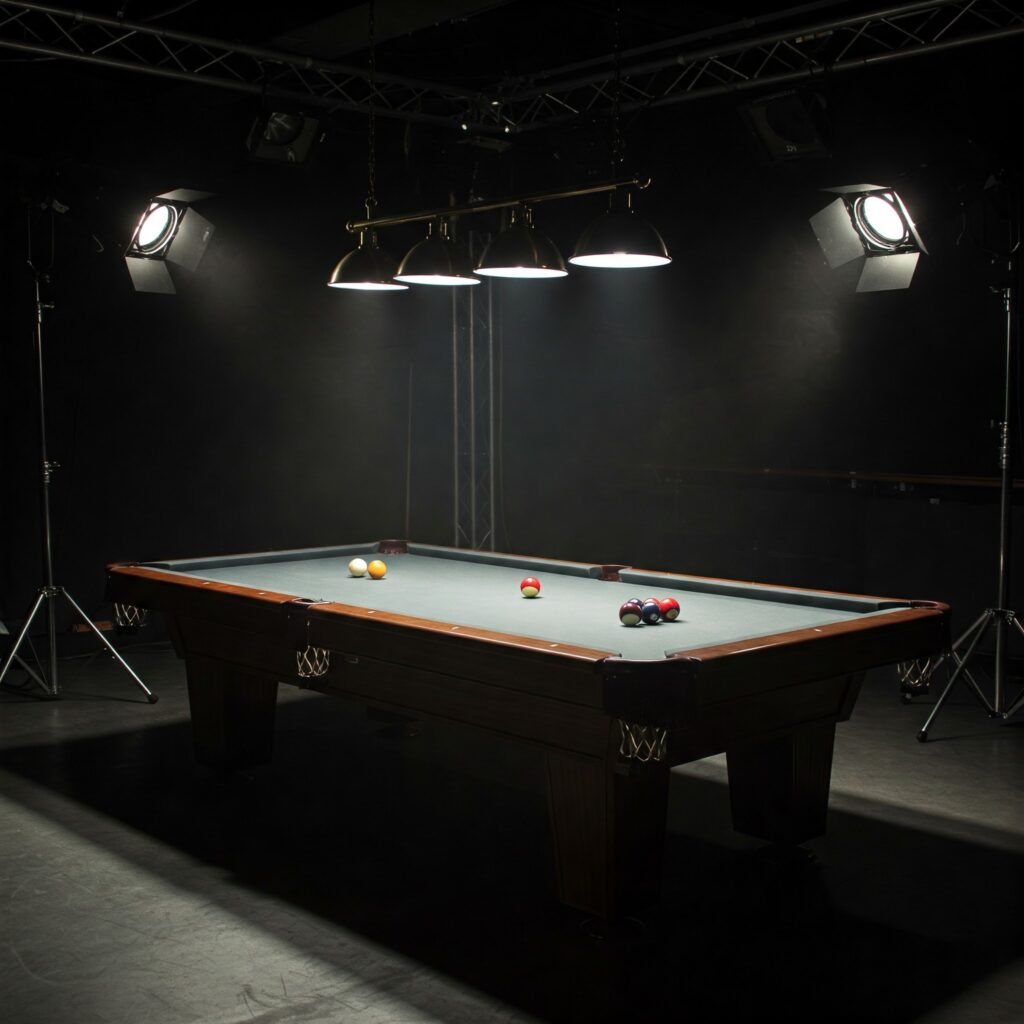Lighting a pool table correctly is one of the most overlooked yet essential aspects of creating an ideal playing environment. Without proper lighting, shadows and glare can disrupt your game, making it difficult to line up shots accurately. Whether you’re setting up a home game room, a bar, or a professional billiards hall, the right lighting setup enhances visibility, reduces eye strain, and elevates the overall experience.
In this comprehensive guide, we’ll explore everything you need to know about lighting a pool table—from selecting the best fixtures to positioning them for optimal performance. Let’s break down the key factors that make a difference.
Why Lighting a Pool Table Is So Important
Lighting a pool table properly ensures that players can see the entire playing surface clearly. Poor lighting leads to:
- Unwanted shadows that obscure balls and pockets
- Glare that strains the eyes
- Inconsistent brightness, making shots harder to judge
A well-lit table improves accuracy and makes gameplay more enjoyable. Additionally, the right lighting enhances the room’s atmosphere, whether you prefer a classic, modern, or industrial look.
1. Choosing the Best Light Fixture for Lighting a Pool Table
Not all lights work well for pool tables. The ideal fixture should:
- Cover the entire playing surface evenly
- Minimize glare and shadows
- Complement the room’s aesthetic
Top Fixture Options for Lighting a Pool Table
A. Pool Table Light Bars
- Rectangular or oval-shaped fixtures designed specifically for billiards
- Hang directly above the table for uniform light distribution
- Available in wood, metal, and modern LED designs
B. Pendant Lights
- Multiple hanging lights spaced evenly over the table
- Adjustable height for customized brightness
- Best for contemporary or industrial-style spaces
C. LED Panel Lights
- Energy-efficient and long-lasting
- Provide bright, flicker-free illumination
- Ideal for professional settings
Fixtures to Avoid
- Single-bulb ceiling lights (create harsh shadows)
- Recessed lighting (uneven coverage)
- Floor lamps (cause glare and reflections)
2. The Ideal Height for Lighting a Pool Table
Hanging your lights at the correct height is crucial for avoiding glare and shadows. Follow these guidelines:
- For 7-foot tables: 30–34 inches above the playing surface
- For 8-foot tables: 32–36 inches above the surface
- For 9-foot tables: 36–40 inches above the surface
Pro Tip: Adjust based on fixture size. Larger lights can be hung slightly higher, while smaller ones should be lower for sufficient coverage.
3. How Bright Should Lighting a Pool Table Be?
Brightness is measured in lumens, and the right level depends on your playing needs:
- Casual play: 3,000–4,000 lumens
- Competitive play: 4,000–5,000 lumens
- Professional tournaments: 5,000+ lumens
LED vs. Halogen vs. Fluorescent:
- LED (best choice – energy-efficient, bright, long-lasting)
- Halogen (warmer light but consumes more power)
- Fluorescent (affordable but can flicker over time)
Avoid incandescent bulbs—they generate too much heat and aren’t bright enough.
4. Positioning Lights to Eliminate Shadows
Even the best fixture can cast shadows if placed incorrectly. Follow these tips:
- Center the light directly over the table.
- Ensure full coverage—lights should extend beyond the table edges.
- Use multiple bulbs or LED strips for even brightness.
Test before mounting: Turn on the lights and check for dark spots from different angles.

5. The Best Bulb Types for Lighting a Pool Table
The right bulb affects visibility, energy use, and longevity. Here’s a comparison:
Bulb Type | Pros | Cons |
LED | Energy-efficient, long-lasting, bright | Higher upfront cost |
Halogen | Warm, natural light | High energy use, shorter lifespan |
Fluorescent | Affordable, decent brightness | Can flicker, contains mercury |
Best choice: 5000K LED bulbs (daylight white) for the clearest visibility.
6. Style and Design: Matching Lighting to Your Space
While functionality is key, aesthetics matter too. Consider these styles:
- Classic: Stained wood light bars with vintage finishes
- Modern: Sleek metallic pendant lights or minimalist LED bars
- Industrial: Cage-style fixtures with exposed bulbs
Choose a design that fits your room’s decor while ensuring optimal light distribution.
7. DIY vs. Professional Installation
DIY Installation Tips
- Use a stud finder to secure heavy fixtures.
- Follow manufacturer height recommendations.
- Test brightness before finalizing placement.
When to Hire an Electrician
- If wiring modifications are needed.
- For complex ceiling mounts.
- If unsure about weight support.
8. Energy Efficiency and Cost Considerations
Lighting a pool table for hours can increase energy costs. Here’s how to save:
- Use LED bulbs (consume 75% less energy than halogen).
- Install dimmer switches to adjust brightness as needed.
- Opt for motion sensors in commercial settings to save power.
9. Common Mistakes When Lighting a Pool Table
Avoid these errors for the best results:
❌ Hanging lights too high or too low → Causes shadows or glare
❌ Using the wrong bulb type → Poor visibility or high energy bills
❌ Uneven light distribution → Dark spots on the table
❌ Ignoring room ambient lighting → Contrast issues with surrounding light
10. Maintenance Tips for Long-Lasting Pool Table Lighting
To keep your lighting in top condition:
- Dust fixtures regularly to maintain brightness.
- Replace bulbs before they burn out completely (prevents flickering).
- Check wiring annually for safety.
Final Thoughts on Lighting a Pool Table
Properly lighting a pool table makes a huge difference in gameplay quality. By selecting the right fixture, positioning it correctly, and choosing optimal brightness, you can create a professional-grade setup at home.
Whether you’re a casual player or a serious competitor, investing in the right lighting will improve accuracy, reduce eye strain, and enhance your overall experience. Now that you know the essentials, it’s time to light up your pool table like a pro!
FAQs About Lighting a Pool Table
Q: How many lights do I need for a 7-foot pool table?
A: One 4-foot light bar or 3 pendant lights spaced evenly works best.
Q: Can I use track lighting for a pool table?
A: Not ideal—track lights often create uneven coverage.
Q: What’s the best color temperature for pool table lights?
A: 5000K (daylight white) provides the clearest, most natural light.
Q: How do I reduce glare on a glossy pool table?
A: Use frosted glass shades or diffused LED panels.
By following these expert tips, you’ll ensure perfect lighting for smooth, enjoyable gameplay every time. Happy playing!
